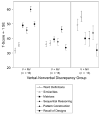Cognitive profiles and social-communicative functioning in children with autism spectrum disorder
- PMID: 12236615
- PMCID: PMC1201493
- DOI: 10.1111/1469-7610.00092
Cognitive profiles and social-communicative functioning in children with autism spectrum disorder
Abstract
Background: Whether there is an unusual degree of unevenness in the cognitive abilities of children with autism spectrum disorder (ASD) and whether different cognitive profiles among children with ASD might index etiologically significant subgroups are questions of continued debate in autism research.
Method: The Differential Ability Scales (DAS) and the Autism Diagnostic Observation Schedule (ADOS) were used to examine profiles of verbal and nonverbal abilities and their relationship to autistic symptomatology in 120 relatively high-functioning children with ADI-confirmed diagnoses of autism.
Results: Discrepancies between verbal and nonverbal ability scores occurred at a significantly higher rate than in the DAS normative sample (30%) in both a younger group of 73 children (56%) with a mean age of 5;5 and an older group of 47 children (62%) with a mean age of 8;11. Discrepancies were mainly in favor of nonverbal ability in the younger group, but occurred equally in favor of verbal and nonverbal abilities in the older group. Comparison of the two age groups suggested a growing dissociation between verbal and nonverbal (and particularly visual processing) skills with age. In the older group, children with discrepantly higher nonverbal abilities demonstrated significantly greater impairment in social functioning, as measured on the ADOS, independent of absolute level of verbal and overall ability.
Conclusions: These findings demonstrate a high rate of uneven cognitive development in children with ASD. Indications of a dissociation between verbal and visual-perceptual skills among the older children, and the specific association of discrepantly high nonverbal skills with increased social symptoms suggest that the nonverbal > verbal profile may index an etiologically significant subtype of autism.
Figures






References
-
- American Psychiatric Association (1994). Diagnostic and Statistical Manual of Mental Disorders (DSM-IV). 4th Edition. Washington, DC: APA.
-
- Bailey A, Phillips W, Rutter M. Autism: Towards an integration of clinical, genetic, neuropsychological, and neurobiological perspectives. Journal of Child Psychology and Psychiatry. 1996;37:89–126. - PubMed
-
- Bolton P, Macdonald H, Pickles A, Rios P, Goode S, Crowson M, Bailey A, Rutter M. A case-control family history study of autism. Journal of Child Psychology and Psychiatry. 1994;35:877–900. - PubMed
-
- Carroll, J.B. (1993). Human cognitive abilities: A survey of factor-analytic studies. New York: Cambridge University Press.
-
- Cohen IL. An artificial neural network analogue of learning in autism. Biological Psychiatry. 1994;36:5–20. - PubMed
Publication types
MeSH terms
Grants and funding
LinkOut - more resources
Full Text Sources
Medical

